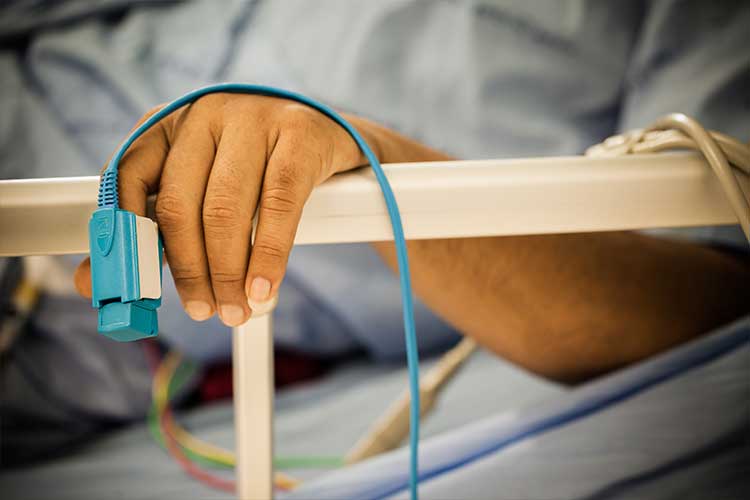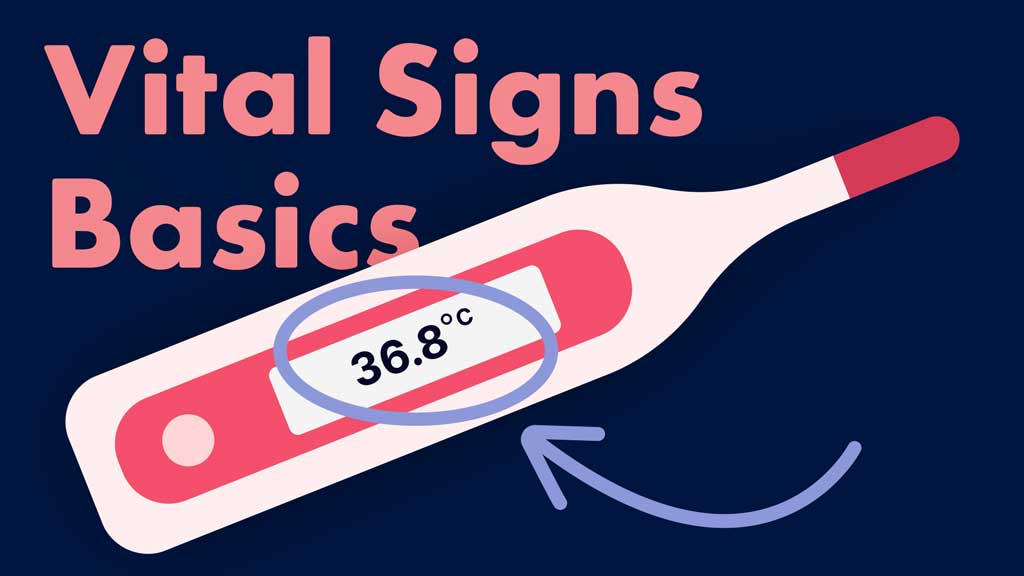This article provides a brief overview of vital signs and is to be used in conjunction with your organisation's policies and procedures.
Note: This article does not encompass reasons why or when to conduct a vital sign assessment - rather, it serves as a summary of each vital sign. All ranges listed are for adults, and this overview does not discuss paediatrics.
1. Level of Consciousness
The first vital sign that a healthcare worker may note is a patient’s level of consciousness.
AVPU Assessment
An AVPU scale is a rapid assessment tool used in healthcare to measure a patient’s consciousness state.
A stands for Alert
The patient is aware of the environment and is opening their eyes spontaneously.
V stands for Verbal
The patient’s eyes do not open spontaneously; rather, they open in response to a verbal stimulus directed towards them.
P stands for Pain
The patient’s eyes do not open spontaneously or to verbal stimuli; they will only respond to painful stimuli directed towards them. A pain stimulus includes touch, and if there is still no response, the health professional can attempt other painful stimuli, such as the trapezius squeeze.
U stands for Unresponsive
The patient is not responding spontaneously or to verbal or painful stimuli.
(Romanelli & Farrell 2023)
Glasgow Coma Scale
Read: Neurological Assessment and GCS
The Glasgow Coma Scale (GCS) can be used for a more in-depth approach to further assess a patient’s level of consciousness.
Important Considerations
Keep in mind that factors such as sleep, alcohol and medications can influence a person’s level of consciousness.
2. Respiratory Rate
What is Respiratory Rate?
Respiratory rate is the number of breaths a person takes per minute.
Respiratory Rate Assessment
Respiratory rate changes are one of the first signs of medical deterioration, but are frequently missed or poorly measured (Kayser et al. 2023).
Respiratory rate can be measured accurately by watching the rise and fall of the chest, placing hands on the person’s chest or back, and counting breaths for a full minute (Open RN 2021).
Normal Respiratory Rate
The normal resting adult respiratory rate is between 12 and 20 breaths per minute (Queensland Government 2024).
Note that children have different normal ranges than adults, and these vary depending on the child’s age (RCHM 2023).
Read: Paediatric Respiratory Assessment
Important Considerations
As well as assessing respiratory rate, it is also crucial to note other aspects of a respiratory assessment, such as work of breathing, adventitious sounds or lack of sounds (Open RN 2021).
A patient’s respiratory rate can be affected by whether they are resting or have been moving.
3. Oxygen Saturation

What is Oxygen Saturation?
This vital sign ensures that hypoxia is noticed in a patient and is used to evaluate the effectiveness of oxygen therapy.
Oxygen Saturation Assessment
Oxygen saturation is generally measured through pulse oximetry.
Normal Oxygen Saturation Range
Normal oxygen saturation is considered to be a peripheral capillary oxygen saturation (SpO2) of 95 to 100% (Torp et al. 2023).
However, for patients who retain carbon dioxide, such as those with chronic obstructive pulmonary disease (COPD), the target SpO2 is between 88 and 92% (Barnett et al. 2022).
Important Considerations
Pulse oximetry results can be influenced by factors such as blue or black nail polish on the fingernail used for the reading, cold extremities with poor blood flow, or excessive movement (Torp et al. 2023).
4. Blood Pressure
What is Blood Pressure?
Blood pressure is the force of blood as it flows through the artery walls during the contraction and relaxation of the heart. It is measured in millimetres of mercury (mmHg).
Blood Pressure Assessment
This vital sign takes into account systolic and diastolic measurements.
A high blood pressure (hypertension) or low blood pressure (hypotension) are signs of clinical deterioration and must be appropriately managed by healthcare staff. Manual blood pressures should be taken to ensure the accuracy of the results.
Blood pressure can also be measured from lying to standing to determine if there is a postural drop (orthostatic hypotension). A postural drop increases a patient’s risk of dizziness and falls (Ringer et al. 2025).
Normal Blood Pressure Range
For most adults, a normal resting BP should be less than 130/85 mmHg (Queensland Government 2024).
Healthcare professionals should note that drastic changes in blood pressure - even if they are in within the normal range - can be a sign of clinical deterioration. Therefore, it’s vital to understand what is normal for each patient, as this is highly individualised (Queensland Health 2023).
Note that children have different normal ranges than adults, and these vary depending on the child’s age (RCHM 2023).
Important Considerations
Activities that may influence BP measurements include exercise and pain.
5. Heart Rate
What is Heart Rate?
The heart rate is how many times the heart beats per minute.
Normal Heart Rate Range
The normal resting heart rate for adults is 60 to 100 beats per minute (bpm) (Queensland Government 2024).
This result may be influenced by fitness level, age, illness and emotions (Healthdirect 2024). When measuring heart rate, one can also note heart rhythm and strength of the pulse.
Note that children have different normal ranges than adults, and these vary depending on the child’s age (RCHM 2023).
6. Temperature
Read: Vital Signs: Temperature Checking
What is Temperature?
Temperature measures the body’s ability to create and expel heat.
Temperature Assessment
Body temperature can be measured in a variety of ways, including:
- Orally
- Rectally
- Axillary (armpit)
- Tympanically (ear)
- Through scanning the skin on the forehead.
Normal Temperature Range
A normal temperature is considered to be between 36.5°C and 37.5°C (Osilla et al. 2023).
7. Pain
8. Urinalysis
A dipstick - a thin, plastic stick with strips of chemicals on it - is placed in the urine to detect abnormalities. The chemical strips change colour if certain substances are present or if their levels are above normal.
A dipstick test can check for:
- pH
- Protein (albumin)
- Glucose
- Ketones
- Bilirubin
- Blood
- Urobilinogen
- Nitrite
- Leucocyte esterase.
(RCPA 2024)
The dipstick test is a helpful diagnostic tool in identifying conditions such as urinary tract infections (RCPA 2024).
9. Weight
Weight is generally measured upon admission and weekly thereafter, unless there are specific circumstances (e.g. fluid overload risk, eating disorder risk) where it may be measured more frequently.
A person’s weight is vital for calculating medication dosages and assessing nutritional status. It’s imperative that the weighing is completed on the same scale for consistency and to reduce the inaccuracy of results. Further, in measuring fluid status, it’s important that a person is weighed at the same time of day and in roughly the same amount of clothing to appropriately assess fluid balance (Marshall & Roe 2024).
10. Blood Glucose Levels
Blood glucose level (BGL) is measured in millimoles per litre (mmol/L) and a normal range is considered to be 4.0 to 7.8 mmol/L, although people living with diabetes may have discussed individual target ranges with their doctor (Diabetes Australia 2024.
BGL can be measured using a blood glucose meter. For people living with diabetes, BGL should be monitored at certain times of the day as advised by their treating practitioner (Diabetes Australia 2025).
Test Your Knowledge
Question 1 of 3
What does the ‘P’ in the AVPU scale represent when assessing a patient's level of consciousness?
Topics
Further your knowledge
 Free
Free Free
Free Free
Free Free
Free Free
Free Free
Free Free
Free Free
FreeReferences
- Barnett, A, Beasley, R, Buchan, C et al. 2022, ‘Thoracic Society of Australia and New Zealand Position Statement on Acute Oxygen Use in Adults: ‘Swimming Between the Flags’ ‘, Respirology, vol. 27, no. 4, viewed 17 September 2025, https://pmc.ncbi.nlm.nih.gov/articles/PMC9303673/
- Diabetes Australia 2024, Blood Glucose Level Range, Diabetes Australia, viewed 17 September 2025, https://www.diabetesaustralia.com.au/managing-diabetes/blood-glucose-range/
- Diabetes Australia 2025, Blood Glucose Monitoring, Diabetes Australia, viewed 17 September 2025, https://www.diabetesaustralia.com.au/managing-diabetes/blood-glucose-monitoring/
- Healthdirect 2024, Resting Heart Rate, Australian Government, viewed 17 September 2025, https://www.healthdirect.gov.au/resting-heart-rate
- Kayser, SA, Williamson, R, Siefert, G et al. 2023, ‘Respiratory Rate Monitoring and Early Detection of Deterioration Practices’, Br J Nurs., vol. 32, no. 13, viewed 17 September 2025, https://pubmed.ncbi.nlm.nih.gov/37410682/
- Open RN 2021, ‘Chapter 10 Respiratory Assessment’, in K Ernstmeyer & C Christman (eds.), Nursing Skills, Chippewa Valley Technical College, Eau Claire, viewed 17 September 2025, https://www.ncbi.nlm.nih.gov/books/NBK593192/
- Osilla, EV, Marsidi, JL, Shumway, KR & Sharma, S 2023, ‘Physiology, Temperature Regulation’, StatPearls, viewed 17 September 2025, https://www.ncbi.nlm.nih.gov/books/NBK507838/
- Marshall, JR & Roe, S 2024, ‘Vital Signs, Height, and Weight’, Health Science Concepts and Skills, 2nd edn, The Goodheart-Willcox Company, Inc., Tinley Park, pp. 550-97, viewed 17 September 2025, https://www.g-wonlinetextbooks.com/health-science-concepts-skills-review-2024/564
- Queensland Government 2024, Clinical Measurements (Adult), Queensland Government, viewed 17 September 2025, https://www.ccm.health.qld.gov.au/adult-health-checks/clinical-measurements-adult
- Queensland Health 2023, Recognition of the Deteriorating Resident, Queensland Government, viewed 17 September 2025, https://www.health.qld.gov.au/clinical-practice/guidelines-procedures/clinical-pathways/residential-aged-care-clinical-pathways/all-pathways/recognition-of-the-deteriorating-resident
- Ringer, M, Hashmi, MF & Lappin, SL 2025, ‘Orthostatic Hypotension’, StatPearls, viewed 17 September 2025, https://www.ncbi.nlm.nih.gov/books/NBK448192/
- Romanelli, D & Farrell, MW 2023, ‘AVPU Scale’, StatPearls, viewed 16 September 2025, https://www.ncbi.nlm.nih.gov/books/NBK538431/
- The Royal Children's Hospital Melbourne 2023, Acceptable Ranges for Physiological Variables, RCHM, viewed 17 September 2025, https://www.rch.org.au/clinicalguide/guideline_index/normal_ranges_for_physiological_variables/
- The Royal College of Pathologists of Australasia 2024, Urine Dipstick, RCPA, viewed 17 September 2025, https://www.rcpa.edu.au/Manuals/RCPA-Manual/Pathology-Tests/U/Urine-dipstick
- Torp, KD, Modi, P, Pollard, EJ & Simon, LV 2023, ‘Pulse Oximetry’, StatPearls, viewed 17 September 2025, https://www.ncbi.nlm.nih.gov/books/NBK470348/
 New
New 
